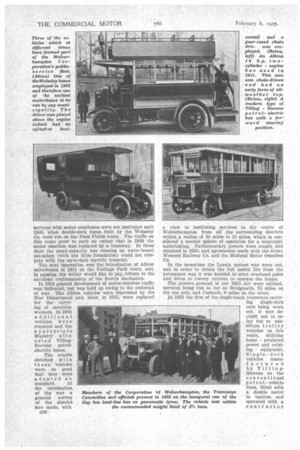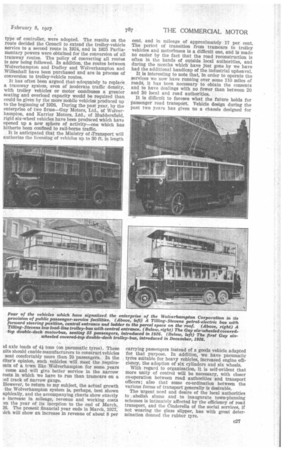HOW WOLVERHAMPTON'S SERVICES GROW.
Page 91

Page 92

Page 93

If you've noticed an error in this article please click here to report it so we can fix it.
The Birth and Growth of an Important Municipal Passenger Service.
By C. Owen Silvers, A.NLI.E.K, M.Inst.T., General Manager and Engineer, Wolverhampton Corporation Transport Department.
A TOINERHAMPTON is well placed, from the V V geographical and industrial point of view, for the 2velopment of road transport. The town is built on hill culminating in the imposing fifteenth-century Colgiate Church of St. Peter. This is the dividing line ' the two great watersheds of the Trent and the Evern, draining, therefore, on one side ilk° the Bristol hannel and on the other into the North Sea.
Being on the fringe of the "Black Country," eastards and southwards it penetrates into thickly poputed industrial areas, and to the north of west we lye open country, with no large towns on the Shroplire side between it and the Welsh coast.
The Wolverhampton Town Council has consistently Id a reputation for being progressive and enterprisg, and its transport committee has done its full are towards the town's development. The nucleus the existing system was a small company-owned Irse tramway, purchased by the Corporation in May, 00. Electricity was adopted for motive power, but stead of adopting the overhead wires, the Lorain rface-contact system was used. Twenty years' experice with this system proved it to be a commercial ccess and the best of the surface-contact systems.
The first length operating electrically was opened on February 6th, 1902, and the routes within the borough were soon carrying their quota of passengers. Throughrunning agreements on the adjoining company's lines were made in 1905.
Experiments were made with the petrol motoromnibus as •early as 1903, when a Milnes-Daimler vehicle was operated over several routes, but regular services with motor omnibuses were not instituted until 1905, when double-deck buses built by the WoLseley Co. were run on the Penn Fields route. The traffic on this route grew to such an extent that in 1909 the motor omnibus was replaced by a tramway. In those days the small-capacity bus running on water-bound macadam (with but little foundation) could not compete with the up-to-date electric tramcar.
The next banovation was the introduction of Albion motorbuses in 1911 on the Fallings Park. route, and, in passing, the writer, would like to payttribute to the excellent craftsmanship of the Scotch mechanics.
In 1914 general development of motor-omnibus traffic was indicated, but was held up owing to the outbreak of war. The Albion vehicles were impressed by the War Department and, later, in 1915, were replaced for the carrying of munition workers. In 1916 additional vehicles were required and the appropriate Mipistry a 1 1 oc a ted TillingStevens petrolelectric buses.
The results obtained with these vehicles were so good that they were adopted as standard. At the termination
of the war a Members of the Corporation o general survey Committee and officials present in of the district Guy low load-line bus on pneumat was made, with the recommended we a view to instituting services to the centre of Wolverhempton from all the surrounding districts within a radius of 10 miles to 15 miles, which is considered a normal sphere of operation for a municipal undertaking. Parliamentary powers were sought and obtained in 1920, and agreements made with the Great Western Railway Co: and the Midland Motor Omnibu Co.
In the meantime the Lorain system was worn out, and in order to obtain the full useful life from the permanent way it was decided to erect overhead poles and wires to convey current to operate the trams.
The powers granted in our 1920 Act were utilized, services being run so far as Bridgnorth, 15 miles on the one side, and Cannock, 9 miles on the other.
jn 1923 the first of the single-track tramways carry
ing single-deck cars being worn out,' it was decid4d . not to relay but to substitute trolley vehicles on this route, utilizing home produced power and existing equipment. Single-deck vehicles manuf a ctured by TillingStevens on the conventional petrol-vehicle lines, fitted with a double motor in tandem and operated with a contractor
type of controller, were adopted. The results on the route decided the Council to extend the trolley-vehicle service to a second route in 1924, and in 1925 Parliamentary powers were obtained for the conversion of all tramway routes. The policy of converting all routes is now being followed. In addition, the routes between Wolverhampton and Dudley and Wolverhampton and Willenhall have been purchased and are -in process of conversion to trolley-vehicle routes.
It has often been argued that adequately to replace a tramway system, even of moderate traffic density, with trolley vehicles or motor omnibuses a greater seating and overload capacity would be required than could be given by the more mobile vehicles produced up to the beginning of 1926. During the past year, by the enterprise of two firms—Guy Motors, Ltd., of Wolverhampton, and Karrier Motors, Ltd., of Huddersfield, rigid six-wheel vehicles have been produced which have opened up a new sphere of activity—one which has hitherto been confined to rail-borne traffic.
It is anticipated that the Ministry of -Transport will authorize the licensing of vehicles up to 30 ft. in length
Id axle loads of 41 tons (on pneumatic tyres). These nits should enable manufacturers to construct vehicles seat comfortably more than 70 passengers. In the Liter's opinion, such vehicles will meet the requireants of a town like Wolverhampton for some years come and will give better service in the narrow reets in which we have to run than tramcars on a :ed track of narrow gauge.
However, to return to my subject, the actual growth the Wolverhampton system is, perhaps, best shown aphically, and the accompanying charts show exactly e increase in mileage, revenue and working costs we the year of its inception to the end of March, M. The present financial year ends in March, 1927, dch will show an increase in revenue of about 8 per cent. and in mileage of approximately 17 per cent. The period of transition from tramcars to trolley vehicles and motorbuses is a difficult one, and is made no easier by the fact that the road reconstruction is often in the hands of outside local authorities, and during the months which have just gone by we have had the additional handicap of the industrial upheaval. It is interesting to note that, in order to operate the services we now have running over some 110 miles of roads, it has been necessary to obtain the consents and to have dealings with no fewer than between 20 and 30 local and road authorities.
It is difficult to foresee what the future holds for passenger road transport. Vehicle design during the past two years has given us a chassis designed for carrying passengers instead of a goods vehicle adapted for that purpose. In addition, we have pneumatic tyres suitable for heavy vehicles, increased engine efficiency, the adoption of six cylinders and six wheels.
With regard to organization, it is self-evident that more unity of control will be necessary, with closer co-operation between road authorities and transport officers; also that some co-ordination between the various forms of transport generally is desirable.
The urgent need and desire of the local authorities to abolish slums and to inaugurate town-planning schemes is intimately affected by the efficiency of road transport, and the Cinderella of the social services, if not wearing the glass slipper, has with great determination donned the rubber tyre.




































































































































































































